The Jewish Labor Bund’s Medem Sanatorium: 1926-1942
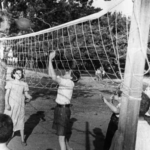
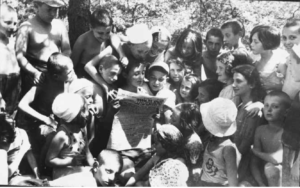
Children at the Medem Sanatorium reading the Bund’s daily newspaper, the Folkstsaytung
Secularism and enlightenment swept through the insular world of East European Jewry, starting in the middle of the 19th century, and ending in the 20th with the rise of Zionism, Marxism, communism, Territorialism, Folkism, assimilationism, anarchism, and, chief among them, Bundism (the social-democratic labor movement of the Jewish working class in Eastern Europe). This last, the Jewish Labor Bund, founded in Vilnius in 1897, became the prevailing movement among these various modern currents.
The historian Bertram Wolfe called the Bund, “The largest and best organized body of workingmen inside the Russian empire.” Plekhanov, founder of the Russian social-democratic movement said, “From a certain point of view, the Jewish workers may be considered the vanguard of the labor army in Russia.” In 1906, with 40,000 members, the Bund was the largest socialist group in the Russian Empire. Organizing over 100,000 laboring Polish Jews in the 30’s, from porters, to slaughterers, retail clerks, barbers, garment workers, leather workers, and others, it was the most powerful body of organized working people inside independent Poland. One quarter of all unionized workers in Poland were led by the Bund, giving them enormous power. In 1938, in the municipal elections in 89 Polish cities and towns, the Bund won 55% of the votes cast, more than all the other Jewish parties put together.
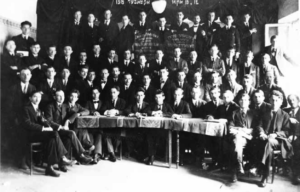
Bundist Leatherworkers Union in Lublin, Poland, 1919. (All
photographs, with permission, from Twenty Years with the
Jewish Labor Bund: A Memoir of Interwar Poland by Bernard
Goldstein, translated and edited by Marvin Zuckerman,
Purdue University Press, 2016).
The Bund As Cultural Movement
The Bund, however, was much more than simply a political party. It was a cultural force that strove to uplift the impoverished Jewish laboring masses spiritually and culturally. To this end, the Bund surrounded itself with a network of communal organizations, attracting thousands of working-class Jews.
Together with the left Labor Zionists, the Bund administered a network of secular Yiddish schools. At its peak, in 1920, its TSYSHO (Tsentrale Yidishe Shul Organizatsye or Central Yiddish School Organization) maintained 219 institutions with 24,000 students, spread across 100 locations, including 46 kindergartens, 114 elementary schools, 6 high schools, 52 evening schools, and a pedagogical institute in Vilnius.
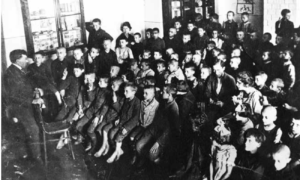
Schoolchildren in a Bundist secular class in Warsaw, 1919,
being taught in Yiddish by Shloyme Gilinsky, later director
of the Medem Sanatorium. Notice children too poor to own
a pair of shoes, with heads shaved to rid them of lice
There were evening classes for workers, reading circles, lecture evenings, and concerts.
The Bund also maintained a youth organization, Tsukunft (Future), which numbered 15,000 members on the eve of WW II; a children’s organization, SKIF (Sotsialistishe Kinder Farband—Socialist Children’s Association) blending scout activities, sports events, politics; and a sports organization, Morgnshtern, the largest such organization in all of Poland, Jewish or Polish.
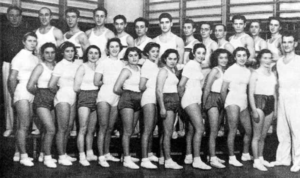
Gymnasts of the Bund’s Morgnshtern
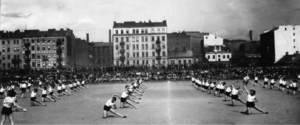
Exhibition by Morgnshtern athletes, Warsaw, 1937
The Bund also had a women’s organization (YAF–Yidishe Arbeter Froy—Jewish Working Woman): In Bundist Counterculture in Interwar Poland (Syracuse University Press, 2009) Jack Jacobs notes that “Jewish women played leading roles in the Bund’s formative years and participated in that party in relatively large numbers during the years of the Russian Empire.” (82). During the years of Polish independence, however, their representation in Bund leadership positions declined. Nevertheless, among the leaders, speakers, organizers, and elected officials in the Bund, many were women.
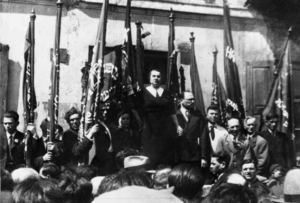
May Day demonstration in Lublin, Poland, 1936. Speaker, Bella Shapiro, leader of the Bund in Lublin and deputy to the Lublin City Council
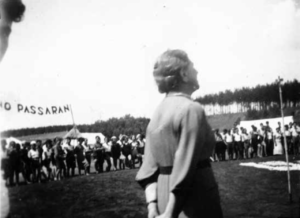
Anna Heller Rozental, a leading member of the
Bund, addressing a SKIF summer camp, 1937
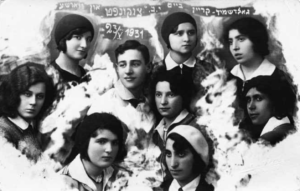
A group of Tsukunft women, Warsaw, 1931
The Medem Sanatorium
Chief among the constellation of cultural, educational, and other activities revolving around the Bund, was its “crown jewel,” the Medem Sanatorium.
Near the Polish village of Myedzeszin, about 20 miles outside of Warsaw, between the two World Wars, the Bund established a sanatorium for undernourished and diseased children of the Jewish slums of Poland.* It was to have the latest medical equipment for the diagnosing and prevention of tuberculosis and other diseases prevalent among the children; it was to have emancipated, progressive teachers; it was to provide the children all year round with scientifically planned, nourishing food—milk, eggs, butter, bread, “luxuries” they seldom ever had in their stomachs; and, it was not merely to entertain, nourish, and cure them, but also to teach them, uplift them spiritually and culturally, imbue them with the values of khavershaft (comradeship) and equality, and introduce them to secular subjects, animal husbandry, nature and the country-side.
All these things the Medem Sanatorium—established in 1926 by TSYSHO—set out to do and did. With the help of funds raised by the Jewish labor movement in America, in addition to the herculean efforts of the Polish Jews themselves, the Medem Sanatorium succeeded so well that educators and pedagogues from all over the world visited and learned from the methods and approach of this “children’s republic.” Positive articles were published in fifteen languages.
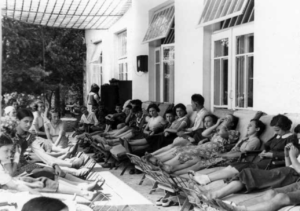
Rest period at the Medem Sanatorium
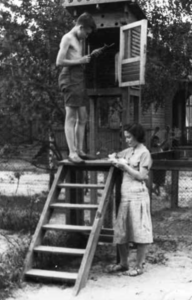
Children at the Medem Sanatorium’s meteorological station
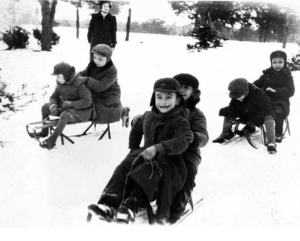
Winter at the Medem Sanatorium
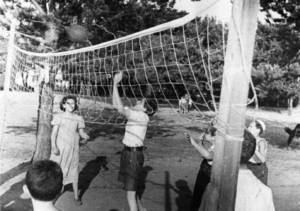
At play at the Medem Sanatorium
The US Holocaust Museum describes the Sanatorium this way: “It bore the name of the Bundist leader Vladimir Medem. The Sanatorium was in existence from 1926 until the summer of 1942. The Medem Sanatorium was an institution for therapy and education. It was renowned throughout Europe for its modern pedagogic methods and served as a model for other similar institutions. Under the leadership of Shloyme F. Gilinsky and the supervision of a staff of physicians and teachers, children who came there from poverty-stricken Jewish workers’ homes received a new lease on life, courage, and hope.” Among them was a young Marek Edelman, a future leader of the heroic 1943 Warsaw ghetto uprising.
According to Jack Jacobs (Bundist Counterculture in Interwar Poland), prominent Yiddish writers—Sholem Asch, Moyshe Nadir, H.D. Nomberg, Daniel Charney—were among those who came to experience the institution. Somewhat less expectedly, the sanatorium was also visited and extolled by Jewish and non-Jewish educators and others with no obvious ties to the Bund, to the socialist movement, or to Yiddish culture. Adolphe Ferriere, a Swiss writer affiliated with the International Bureau of Education and the Jean-Jacques Rousseau Institute, visited in 1930 and was strongly impressed. Works on the Sanatorium are said to have appeared in twenty different countries.
Jacobs notes (pp. 65-72) that Shloyme Gilinsky, the Director and guiding spirit of the Medem Sanatorium, “studied pedagogy first in Warsaw and later in Berlin,” that “all children were given what was determined to be a socialist education,” and that “Gilinsky was especially attracted to the ideas of German pedagogue Berthold Otto.” Finally, “In many ways the Sanatorium’s educational philosophy came to have similarities to the Dalton System, first developed in the United States at the beginning of the twentieth century, which stresses the simultaneous importance of freedom of independence, and of cooperation.”
Victor Gilinsky, Shloyme Gilinsky’s son, related the following to me about his father’s pedagogy:
“My father told me his guiding light was Rousseau’s Emile, or On Education…. Basically, he retained from his own experience, growing up in a village, what most people, including pedagogues, forget: what it is to be a child. He also believed in physical activity, in modern hygiene, scientific inquiry, and he had a great respect for art….My father told me that children needed to be developed physically and mentally, and that, between religion and poverty, children’s lives were being wasted. His primary dedication was to the children and his desire to help them, which overrode any adherence to any particular school of pedagogy.”
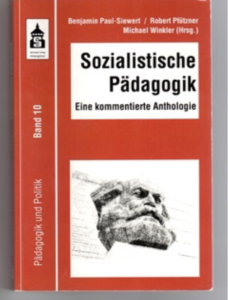
In a German book entitled Sozialistische Paedagogik: Eine Kommentierte Anthologie (“Socialist Pedagogy: An Annotated Anthology”—Schneider Verlag, 2016), Shloyme Gilinsky’s pedagogy, as implemented under his direction at the Medem Sanatorium, is described and discussed alongside the pedagogic approaches of Bertolt Brecht, Karl Marx, Rosa Luxembourg, Chares Fourier, and Robert Owen, among others.
In 1936 a ninety-minute film, Mir Kumen On (We Are On Our Way), was produced in Yiddish (with English subtitles) by the well-known Polish director, Alexander Ford. A fine documentary, with a scenario written by Jacob Pat and Wanda Wasilevska, it first shows, briefly, the deplorable conditions of Jewish life in Poland that made the sanatorium necessary, and then the life in the sanatorium—the food, the playrooms, the chicken coops, the vegetable gardens, the meetings to decide things, the puppet shows and plays, the quarrels, the hygiene and medical treatment, and, above all, the beautiful children and their remarkable teachers. One copy of the film was donated to the museum of Kibbutz Lach’mey Ha-Ghetto’ot (Ghetto Fighters); a DVD copy of it may be purchased from the National Center for Jewish Film at Brandeis University.
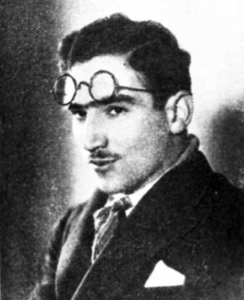
Aleksander Ford, director of Mir Kumen On, youthful doyen of Poland’s politically committed cineasts.
The Medem Sanatorium Book
In memory of the Sanatorium, Luba Gilinsky on the occasion of the tenth anniversary of the death of her husband, Shloyme Gilinsky—Director and guiding spirit of the Sanatorium throughout all its years—published a book in Yiddish, edited by C. S. Kazhdan, called Medem Sanitorye Bukh (Menorah, Tel Aviv, 1971).
It is not just an historical account of a unique Jewish children’s sanatorium. It is much more than that. It includes original songs, poems, plays, and games created by the children themselves and their teachers. It is a marvelous collection of reminiscences and recountings by the surviving students and teachers of what the whole experience “Medem Sanatorium” meant to them. It is a glowing tribute, an unforgettable memorial to the spirit of the Sanatorium, to the Jewish Labor Bund in Poland, and to the Jewish workers who made it possible.
Some of the accounts in the book are heartwarming and also suspenseful and heroic.
Joseph Kerler, the gifted Soviet-Yiddish poet, wrote concerning the Medem Sanatorium Book:
A true memorial has been erected to a shining and creative epoch in onetime Jewish Poland. The book is beautifully put together, with great devotion and love, as well as with great longing and sorrow for the vanished and so-cruelly annihilated.
May the hands of the editors and publishers be blessed.…
A publisher is being sought for a translation of this important book into English.
The Medem Sanatorium Book is a bouquet of flowers on the grave of the murdered Six Million of the Holocaust, and a yerushe (legacy), a passing on of a significant piece of the colorful and vital mosaic that was the vanished life of the Jewish people in Poland.
In 1942, eighty years ago, the Nazi murderers forced over 200 of the children in the Medem Sanatorium, along with their teachers, nurses, doctors, and staff, onto cattle cars, taking them to Treblinka to be gassed and burned.
_________________________
*From Jack Jacobs’ Bundist Counterculture in Interwar Poland (p.69): “A clear majority of the children [in the Medem Sanatorium] grew up in extremely poor homes and in overcrowded conditions.” Jacobs reports that a survey dealing with the period from 1926 to 1936 noted that of the 4,060 children surveyed, all lived in families with at least 6-8 people living in one room, including 868 cases of more than 8 living in one room. He goes on to note that the survey showed that “more than 28 percent of the children did not have a bed of their own in their homes. More than 45 percent of the children from Warsaw lived in housing that lacked electrical lighting, running water, and internal plumbing facilities.”